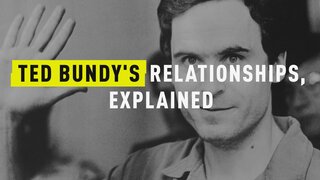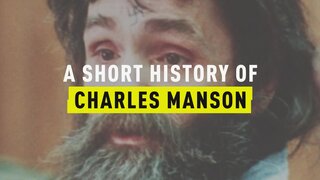Create a free profile to get unlimited access to exclusive videos, breaking news, sweepstakes, and more!
The Creepiest Revelations In ‘The Ted Bundy Tapes’ That Are Giving Us Nightmares
As a rapist, murderer, and necrophile, Ted Bundy committed killing after killing, living undetected for years before he was finally caught. The new Netflix series “Conversations With a Killer: The Ted Bundy Tapes,” sheds light on just how disturbed he truly was.
Brutal attacks in the dead of night. Young girls and women being spirited away, never to be seen again. Severed heads and corpses with freshly-washed hair, whose faces had been painted with makeup.
Ted Bundy and the many vicious acts he committed during his lifetime are what nightmares are made of. As a practiced, efficient killer who terrorized multiple communities across the country for years at a time, Bundy had at least 30 murders credited to his name and managed to get away with most of them before he was finally captured in 1978 and sentenced to death the following year.
Netflix’s latest disturbing — yet addictive — true crime offering compiles the death row interviews of journalists Stephen G. Michaud and Hugh Aynesworth, both of whom sat for extensive interviews with Bundy during the last years of his life.
The four-episode series offers viewers an inside look at one of the most disturbed minds of a generation, unveiling details that are, at turns, horrifying, chilling, and downright obscene. Here are eight revelations from “The Ted Bundy Tapes” viewers won’t soon forget.
1. Bundy claimed to be following the directions of a voice in his head
It’s not a new phenomenon for people who commit violent crimes to claim that a voice in their head made them do it. Still, that doesn’t make it any less creepy hearing how Bundy repeatedly referred to an “entity” or “malignant force” within him, whose will he felt driven to obey.
Bundy said that the entity “controlled him and he would hear a voice and he did as the entity told him to do,” according to Michaud. Bundy’s longtime girlfriend, Elizabeth Kloepfer, also described in an interview with police in 1978 hearing Bundy talk about an unseen force.
“He told me that he was sick and that he was consumed by something that he didn’t understand and that, um, that it — that he just couldn’t contain it,” she said. “He spent so much time trying to maintain a normal life and he just couldn’t do it. He said that he was preoccupied with this force.”
This alleged force would go on to compel Bundy to assault, rape, torture, and murder dozens, if not hundreds, of innocent women. In some cases, he even mutilated and molested their corpses. Was the so-called entity in Bundy’s head a sign of mental illness? Was it simply his own voice, encouraging him to act on his own violent desires? Was Bundy lying? We’ll likely never know.
2. Bundy was a necrophile
Bundy was a necrophile, though he only began to admit it near the end of his life.
While speaking with FBI Special Agent Bill Hagmaier days before his execution, Bundy admitted to severing the heads of “perhaps half a dozen” of his victims, and of commiting necrophiliac acts.
“When he said he was clearing his soul at the end, he wanted me to know that he practiced necrophilia,” Hagmaier said in the final episode of the series. “That was something he never talked about even in the third person before that. You know, the truth is terrible.”
The truth, as crime writer Ann Rule wrote in her book “The Stranger Beside Me,” is that Bundy routinely returned to where he’d dumped his victims’ bodies and put makeup on their faces. He’d wash their hair. He dressed up the bodies to look how he wanted, he once told Hagmaier, according to the book “The Only Living Witness,” written by the same two journalists behind “The Ted Bundy Tapes.”
“If you’ve got time, they can be anyone you want them to be,” Bundy said.
3. Many women thought that their boyfriends could be the suspect
Before Bundy was caught, police had only a sketch to go on and descriptions of his crimes. Still, it was enough that they received numerous tips from women who thought that maybe they were dating the man responsible for the rash of violent crime in their communities.
“We had a lot of women who called and said, ‘I’m concerned that my boyfriend might be this offender.’ Whether his name was Ted or not,” Kathleen McChesney, a Washington detective, said during the Netflix special.
How many other potential Bundys were out there? Were there other men who were committing vicious acts of violence against women, and who were able to continue flying under the radar, just as Bundy did for years? While ultimately, only Kloepfer was right about her boyfriend secretly being the vicious murderer behind this particular string of crimes, the fact that so many women suspected that their significant others were capable of the same kind of sexual violence as Bundy is pretty disturbing all on its own.
4. Bundy managed to fool even those closest to him
Even as Bundy continued to secretly terrorize entire communities, the people in his life did not want to suspect him — not the congregation at his church, not his family, and not his girlfriend, Kloepfer. Her reluctance to believe that Bundy was dangerous isn’t proof of her own naivete, however, but a testament to the absolutely disturbing ability Bundy had not just to blend in to society, but to make others think of him as an exceptionally likeable person.
During an interview with authorities in 1980, Kloepfer expressed feeling doubt about her boyfriend, and recalled several instances that led her to grow suspicious. She’d found strange things in his car and in the house, like a bag of women’s clothing (most likely souvenirs from his killings), a bowl filled with house keys, and a knife under the front seat of his car.
On the night of one woman’s disappearance, Bundy was spending time with Kloepfer and her family — as good boyfriends do — but left early, and then arrived late to her daughter’s baptism the next day, she explained. Freakishly enough, Bundy commented to Klopfer on the disappearance of Brenda Ball — a woman he would later be accused of abducting, assaulting, and killing — telling her, “It’s pretty scary, isn’t it?”
Still, it was hard for Kloepfer to think that Bundy could have done the things she suspected him of.
“In my own mind, there were coincidences that seemed to tie him in,” she told authorities. “Yet, when I would think about our day-to-day relationship, there was nothing there that would lead me to think that he was a violent man capable of doing something like that.”
If ever there was proof that evil can walk among us — and can’t always be picked out of a lineup — it’s Ted Bundy.
5. Bundy killed to cover his tracks
Bundy may have gotten a sick type of satisfaction from brutally killing women, but he also did it out of a skewed sense of pragmatism, Bundy can be heard explaining during one interview featured in “The Ted Bundy Tapes.”
“The emphasis becomes on, ‘don’t get caught,’” Bundy said of his crimes. “Then it becomes a matter of disposing of the problem without leaving any, uh, evidence.”
The problem Bundy referred to were the women he’d assaulted and raped, but hadn’t yet killed.
While it can’t be said for certain that practicality was the driving force behind Bundy’s murders, the thought of dozens of women losing their lives in such a heinous way — and dozens more having to deal with the psychological ramifications of losing a loved one, sometimes a child, in such a heinous way — all because Bundy wanted to be practical sends chills down one’s spine. It seems clear that to Bundy, murder had become as commonplace as any other item on his to-do list.
6. Bundy meticulously planned his jail breaks
It’s no secret that Bundy escaped from police custody not once, but twice, but hearing him describe the care he took in meticulously planning his escape makes it clear why some have described him as an evil genius.
“I psyched, psyched, psyched myself up for weeks. And literally, it took — it took weeks,” he said of his first escape. “I began jumping off the top bunk in my cell in the Garfield County jail. Jumping again and again and again off the top bunk to the floor to strengthen my legs for the impact. I measured, mentally measured the distance from the corner of the courthouse to the alley and from the alley to the riverbed and from the riverbed to the mountains. And I measured my cell and I ran those distances. I ran those distances again and again.”
“I practiced how rapidly I could change my clothes from my courtroom attire to my shorts, and I, uh, got a haircut so that I had a different appearance,” he said.
For his second escape, he secretly sawed a hole in the ceiling of his cell and purposely lost weight so that he could fit into the hole and the crawl space above.
It’s less disturbing, perhaps, to think of criminals as mindless monsters; the thought that Bundy was able to meticulously plan not one, but two jail breaks, showed what a monumental threat he was to the general public before his final capture and, later, execution.
7. The Chi Omega sorority house murders were deeply disturbing
All of Bundy’s crimes were undoubtedly horrific, but there was something especially disturbing about what he did at the Chi Omega sorority house in 1978. Having escaped from jail, Bundy was free again to indulge in his most twisted impulses. Mere weeks after his escape, he snuck into a sorority house in the dead of night and brutally assaulted four women, taking the lives of two of them.
It may seem unusual that someone could viciously assault multiple women in a packed house, but as one officer interviewed in 1978 about the killing said, his victims never “had a chance to cry out.” They were asleep when Bundy attacked them, and some of them just never woke up. Crime scene photos included in the Netflix doc show the women’s beds after the attack: sheets, comforters, and quilts, all stained with blood.
Even more disturbingly, Bundy, after brutalizing four women — some of whom he’d attacked with his teeth, or raped with a hair spray bottle — then broke into another home mere blocks away and attacked another co-ed.
“Obviously we had the same individual, who didn’t get but a few blocks and couldn’t stop himself,” W. Kenneth Katsaris, sheriff in Leon County, Florida, recalled during the Netflix special.
The "behind the curtain" look at one of the most notorious attacks Bundy committed served to highlight why he was known as a monster, and the fear that he spread in the area.
8. The full scope of Bundy’s crimes is greater than we’ll ever know for sure
While Bundy was officially linked to the murders of 30 people, many believe the real number of his victims could be in the hundreds. One person who believes that is Katsaris, who described during the Netflix special Bundy’s remarks to him after authorities discovered the body of 12-year-old Kimberly Leach.
Bundy did not admit to the crime, but instead — referring to the killer as a separate person, as he often did — made a truly disturbing statement.
“I told Ted Bundy that we now have the evidence to charge him with both cases,” Karsaris recalled, referring to the Chi Omega murders and the Leach slaying. “He looked at me and said, ‘When you find the person that committed these crimes that you think I committed, that person is going to be wanted for murders of women in the three digits in six states.’”
The thought of Bundy committing as many brutal killings as he himself suggested and being able to get away with it all for as long as he did is a disturbing thought. What if he hadn’t bungled his attempt to kidnap Carol DaRonch in 1974, inadvertently creating a witness who would later identify him to police? What if an officer hadn’t taken him into custody a year later for suspicious behavior? Would Ted Bundy have been inadvertently allowed to continue killing women across the country, all while leading a double life as a respectable man? Now there’s a chilling thought.
[Photo: Getty Images]






























